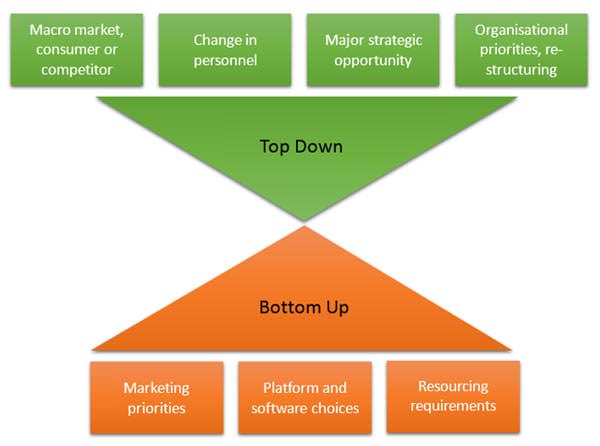A review of digital change management – examining ‘top down’ and ‘bottom up’methods
"Like so many other revolutions, digital marketing has taken hold from the bottom up. Here, we find digital natives steeped in digital culture and practice — twenty- and thirty-somethings who came of age on the social web."
Jake Sorofman, The Rise of the Digital CMO
We often think of Senior Management as being the drivers of change within a business. After all, it is they who have they experience to see when change is necessary, and them who have the power to enact the change itself. However, as the quote above suggests, this is somewhat of a fallacy in the current climate – digital change has bubbled like a kind of ‘groundswell’, often meeting executives who are almost unaware.
Bottom Up Change is Commonplace
There are few better practical illustrations of change coming from the bottom than the growth of social media as a business tool from 2006, then rising in magnitude from around 2009. In an atmosphere where senior management were often unaware of the booming growth, and what it meant, company employees took it upon themselves to create and manage relevant company accounts. It would have been extremely rare for a top level executive to begin these changes.
But such rapid and often unregulated change can throw up its own pitfalls. A 2012 Altimeter paper by Jeremiah Owyang A Strategy for Managing Social Media Proliferation found that the average company of over 1,000 employees had 178 different social media accounts! It was often reported that many of these accounts had ‘died’ (were no longer being updated), the passwords were lost or they were being run by Interns. In all of these scenarios, it could be very damaging to the company involved!
Middle Management Responsibility
The rapidity of change driven by social media is an unusual case, but it is still possibly the biggest change that faced marketing departments in the last decade. Nevertheless, most companies have been able to properly structure their social media activities and halt the groundswell of fragmentation as illustrated above.
Oftentimes, introducing structures and governance has been the job of middle management – being low down enough to see the very bottom up changes, yet high enough to gain senior support and budgets.
Top Down, Bottom Up
Middle management therefore have a vitally important role to play in digital change management, and it is in their skill of meeting both top down and bottom up demands and pressures that can ultimately lead a business through the process.

Middle management are the very epicentre of Top Down, Bottom Up change management. Model from Neil Perkin (Econsultancy) Digital Transformation: Securing Board Buy in Best Practice Guide.
It is also very likely that middle management will become the major ‘change agents’ within a business. So long as they are given the right level of entrepreneurial freedom by the board, they should be the agents for change within an organisation.
Senior Management’s Role
It is very rare for a board to be so well aligned with both company and market to drive everything required from a change management program from the top down. Many board members are not digital natives, and are rarely heavy users of digital media in the same way that younger employees may. Thus while they would like to initiate top down changes, they do not have the required knowledge to do so, and thus rely on middle management to inform them.
Middle Managers as Real Change Agents
While staff at the bottom of the company may act as a catalyst of change, middle management must act as change agent, through making sense of reactionary groundswells and managing the expectations of their seniors. However, without proper Senior Management support, it’s likely that such people would get burnt out – especially when encountering blockers within a business. Thus Senior Managers should act as enablers and facilitators – offering support to middle management through things like budgets, but also through removing blockages when they occur.
So does digital change really come from the bottom up as Jake Sorofman says? I’m not convinced. It may have bubbled from the bottom up, but the middle of many businesses has given it its true shape.
You can read more on how to create a Digital Transformation programme in the Smart Insights guide to Digital Transformation.








